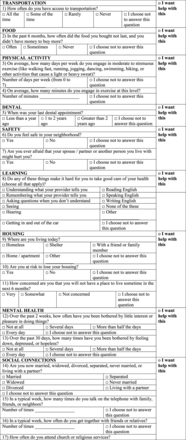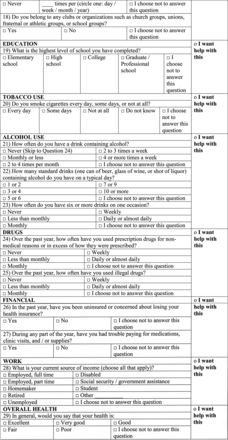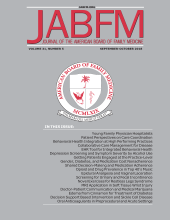Article Figures & Data
Figures
Tables
Domain Descriptor of Positive Screen Percentage with Positive Screen Percentage Asking for Help Physical activity Less than 150 minutes of strenuous exercise per week 53.0 1.6 Dental Last dental appointment ≥1 year ago 25.2 1.6 Alcohol use AUDIT-C* score ≥3 in women or ≥4 in men 14.6 0.8 Overall health Self-rated health as “fair” or “poor”† 13.0 0.0 Tobacco use Current use of cigarettes 12.2 0.8 Finances Lack of medical insurance, concern for losing medical insurance, or problems paying for medications, clinic visits or supplies 11.4 0.0 Work Currently unemployed, receiving disability, or other government assistance 11.4 0.0 Learning Problems with understanding, remembering, seeing, hearing, and English literacy 10.6 0.8 Mental health PHQ-2‡ score ≥3 10.6 0.8 Food Insufficient food and lack of money to buy more 7.3 1.6 Drugs Any use of illicit drugs or prescription drugs for nonmedical purposes 7.3 0.0 Transportation Problems with access to transportation 4.9 0.8 Housing Currently homeless or living in shelter; currently at risk of losing housing; or concern that will lose housing in next 6 months 4.1 0.8 Education Did not complete high school 2.4 1.6 Safety Feeling unsafe in neighborhood or concern that spouse/partner might hurt them 2.4 2.4 Social connections Limited interaction with family, friends, and neighbors 1.6 0.8 Overall with at least one domain 86.2 3.3 Overall with at least one domain with physical activity excluded 70.7 3.3 Note: see Appendix A for full social needs survey.
↵* AUDIT-C is a 3-item validated alcohol screening tool that helps identify persons with hazardous drinking or active alcohol use disorders.
↵† options for health ranking including Excellent, Very Good, Good, Fair and Poor.
↵‡ PHQ-2, the Patient Health Questionnaire-2, is a validated depression screening tool, which inquires about frequency of depressed mood and anhedonia over the past 2 weeks.
Positive Response (%) Neutral (%) Negative Response (%) Information from social needs survey helped during encounter 33.9 64.4 1.7 Knowing patient lives in “cold spot” helped during the encounter 33.3 63.3 3.3 Social needs survey helped change care* 22.5 N/A 77.5 Social needs survey helped me know patient better 52.5 40.8 6.7 Note: see Appendix B for clinician diary response prompts.
↵* for this question, clinicians were not given a neutral response option.
- Table 3.
Themes from Clinician Perspectives Identified in Learning Collaboratives and Clinician Diaries
Themes Findings Example Quotations The act of assessing social needs is difficult and resource intensive Screening is less beneficial for patients that you know well “Some of the folks I have known for 20 plus years, so there wasn't a lot that could surprise me.” Patients may be hesitant to share needs “The patient was very reluctant to complete the survey. He did not report any social needs for any topic and did not ask for help with any topics. However, I actually suspect that the patient has a number of social needs. Talking about the responses made me think he had a number of needs but was embarrassed to mention them.” “I think there's a lot of pride too. Like I had one patient that looked at the survey and he figured out pretty quick what it was and then he just didn't want to do it.” Patients who need help do not come in for visits “It's important to mention that the people who really need it may not be the ones who are actually coming in.” The information is overwhelming for physicians “And I think it does get a bit overwhelming to think about having that burden. I mean as a family practitioner, we already do so much in terms of looking at the whole person, but it just adds another dimension but I don't know how well, right now, we are equipped to deal with.” “We're doing too many things. We have too much to do. We have too little time.” Few resources exist to help patients with social needs Providers want to address social needs but lack agency with respect to addressing social needs “Our resources as a practice are limited because we can't be paying for rides for patients. We can't be, you know, doing some of these things. So really we have to think about what we really want to accomplish with this.” Clinicians are not aware of community resources “One problem is we don't know what resources are even in our community, most of us.” “There's so much that's out there that I never stumble upon until like I have one patient who has this one resource that I end up using. It would be helpful just to know what all is there, you know?” Practices lack adequate support to address social needs “It doesn't do you much good in a system to identify issues or problems if the system doesn't have any way to address them.” Screening for social needs did not seem to help with social service delivery, but it did help clinicians to know their patients and seems to change clinician-patient interactions May change how clinician interacts with patient “The patient had a new diagnosis of diabetes and told me she did not go to the diabetes education classes because they were $250 per class. With the survey, my reaction was more understanding and I was less inclined to assume she did not care about her health.” “[My patient] had a mammogram ordered from wellness visit last year but never had it done. Knowing she was from a resource poor area, I took extra time asking her about barriers that would prohibit her from getting this done this year.” May increase clinician awareness “It's a reminder that our patients, in filling out these surveys and learning more about them, that our patients have lives outside of just the medicine that we give them.” May not change practice “I don't think that other than maybe a little bit of insight making me think about those community factors more than I would if I hadn't had the survey to look at […] I haven't changed anything.” Screening for social needs can cause harms “Does it make a difference that I'm actually surveying these people? Am I doing this for naught? And I guess that would be another…what's the outcome going to do? Because I always want to do good. I took an oath to do no harm.” More evidence is needed about how to collect social needs, how to help address social needs, and the impact on health Some clinicians questioned if health care system is the right place to address social needs “For at least social needs, I would think the doctor is a small little isolated part that could be addressed by a bigger system […] it seems like there's probably a better structure to gather the data to identify what the needs are and to actually address the needs that is probably not the doctor's office.” “We're not asking the right questions. It makes me think well, gosh, what would be the right questions to ask to identify things that the doctor might be able to help with.” More evidence is needed about whether addressing social needs improves health outcomes “I think the bottom line is: Does it improve social or health outcome? I mean that's what we want to know the answer to. Is investing your time and doing these things, does it pay off? Does it actually help the patient? It would be nice to see data that shows that it does.” Clinicians have ideas about how to address social needs better “Maybe a print-out of the basic resources in there that we could just easily pick up.” “What about group sessions that we would hold here for people with similar county, in the same county, and similar issues and we could talk to them all at one time? I mean some people may be embarrassed by this but then also they could support each other.”










